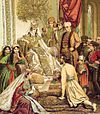| Rusudan | |
|---|---|
 Fresco inside Gelati monastery thought to be showing queen Rusudan of Georgia. Fresco inside Gelati monastery thought to be showing queen Rusudan of Georgia. | |
| Queen of Georgia (more...) | |
| Reign | 1223–1245 |
| Predecessor | George IV |
| Successor | David VII |
| Born | 1194 |
| Died | 1245 (aged 51) Tbilisi |
| Burial | Gelati Monastery |
| Spouse | Ghias ad-din |
| Issue | David VI Gurju Khatun |
| Dynasty | Bagrationi |
| Father | David Soslan |
| Mother | Tamar of Georgia |
| Religion | Georgian Orthodox Church |
| Khelrtva |  |

Rusudan (Georgian: რუსუდანი, romanized: rusudani) (c. 1194–1245), a member of the Bagrationi dynasty, ruled as queen regnant (mepe) of Georgia in 1223–1245.
Life
Daughter of Queen Tamar of Georgia by David Soslan, she succeeded her brother George IV on 18 January 1223. George's untimely death marked the beginning of the end of the Georgian Golden Age. Rusudan was unable to preserve whatever was gained by her mother and brother. She was known as a beautiful woman devoted to pleasure, whose hand was sought by her Muslim neighbors. In Muslim sources, such as Ata-Malik Juvayni, Rusudan was known as Qiz-Malik, from the Turkish qiz, "maiden", and the Arabic malik, "king".
In the autumn of 1225, Georgia was attacked by the Khwarazmshah Jalal ad-Din Mingburnu, pursued by the Mongols. The Georgians suffered bitter defeat at the Battle of Garni, and the royal court with King Rusudan moved to Kutaisi, when the Georgian capital Tbilisi was besieged by the Khwarezmians. A year later Jelal ad-Din took Tbilisi on 9 March 1226. The citizens fought courageously and over 100,000 lost their lives when the city fell to the Khwarezmians. The defeated Georgians were ordered to change religion and become Muslims, but refused and almost the whole population of Tbilisi was massacred. In February 1227, the Georgians took advantage of Jelal ad-Din's failures in Armenia, and retook Tbilisi, but soon were forced to abandon the city – which they themselves had set alight in their battle with the occupation forces. Rusudan made an alliance with the neighbouring Seljuk rulers of Rüm and Ahlat, but the Georgians were routed by the Khwarezmians at Battle of Bolnisi, before the allies could arrive (1228).
The Khwarezmians were superseded by the Mongols. They advanced into Georgia in 1235. Devastated and plundered by Jelal ad-Din's incursions, Georgia surrendered without any serious resistance. By 1239, all the country was under the Mongol yoke, and had to accept the Georgian–Mongolian treaty of 1239. Rusudan had to pay an annual tribute of 50,000 gold pieces and support the Mongols with a Georgian army of 80,000 soldiers.
Fearing that her nephew David would aspire to the throne, Rusudan held him prisoner at the court of her son-in-law, the sultan Kaykhusraw II, and sent her son David to the Mongol court to get his official recognition as heir apparent. She died in 1245, still waiting for her son to return.
Family and personal life
She married in 1224 to the Seljuk prince Ghias ad-Din, a grandson of Kilij Arslan II who converted to Christianity on his marriage. They were the parents of David VI of Georgia and a daughter named Tamar, who married her cousin, the sultan Kaykhusraw II, and following his death in 1246, the Pervane Mu'in al-Din Suleyman as one of the preconditions of the peace settlement.
Ghias ad-Din's position at the Georgian court was weak and the spousal relationship was strained due to Rusudan's unfaithfulness. Reporting her scandalous love affairs and adulterous way of life, ibn al-Athir recounts that on one occasion Rusudan was surprised by her husband in bed in the arms of a slave ("mamluke"). As Ghias ad-din refused to condone this fact, ibn al-Athir continues, Rusudan had him moved to "another town" under strict supervision. His name does not appear on coins issued in the name of Rusudan.
References
- Mikaberidze, Alexander (2015-02-06). Historical Dictionary of Georgia. Rowman & Littlefield. p. 576. ISBN 9781442241466.
- Minorsky, Vladimir, "Tiflis", in: M. Th. Houtsma, E. van Donzel (1993), E. J. Brill's First Encyclopaedia of Islam, 1913-1936, p. 756. Brill, ISBN 90-04-08265-4
- Mikaberidze, Alexander (2007). Historical dictionary of Georgia. Lanham, Md.: Scarecrow Press. p. 21. ISBN 978-0-8108-5580-9.
- Ibn Al-Athir, in Richards 2010, pp. 244–245
- Djaparidze 1995, pp. 181–182.
Sources
- Wilhelm Baum (2007). "Rusudani (Russutuna)". In Bautz, Traugott (ed.). Biographisch-Bibliographisches Kirchenlexikon (BBKL) (in German). Vol. 27. Nordhausen: Bautz. cols. 1179–1184. ISBN 978-3-88309-393-2.
- Djaparidze, Gotcha I. (1995). საქართველო და მახლობელი აღმოსავლეთის ისლამური სამყარო XII-XIII ს-ის პირველ მესამედში [Georgia and the Near Eastern Islamic world in the 12th–13th century] (PDF) (in Georgian). Tbilisi: Metsniereba.
- Richards, Donald Sidney, ed. (2010). The Chronicle of Ibn Al-Athir for the Crusading Period from Al-kamil Fi'l-ta'rikh, Part 3: The Years 589-629/1193-1231: the Ayyubids After Saladin and the Mongol Menace. Farnham: Ashgate Publishing. ISBN 978-0754669524.
| Rusudan of Georgia Bagrationi dynasty | ||
| Preceded byGeorge IV | King of Georgia 1223–1245 |
Succeeded byDavid VI |
| Kings of United Georgia | |||||||||
|---|---|---|---|---|---|---|---|---|---|
| |||||||||
- Kings of Georgia
- Queens regnant in Europe
- 1190s births
- 1245 deaths
- 13th-century monarchs in Asia
- 13th-century queens regnant
- 13th-century people from Georgia (country)
- 13th-century women from Georgia (country)
- 12th-century people from Georgia (country)
- 12th-century women from Georgia (country)
- Daughters of queens regnant
